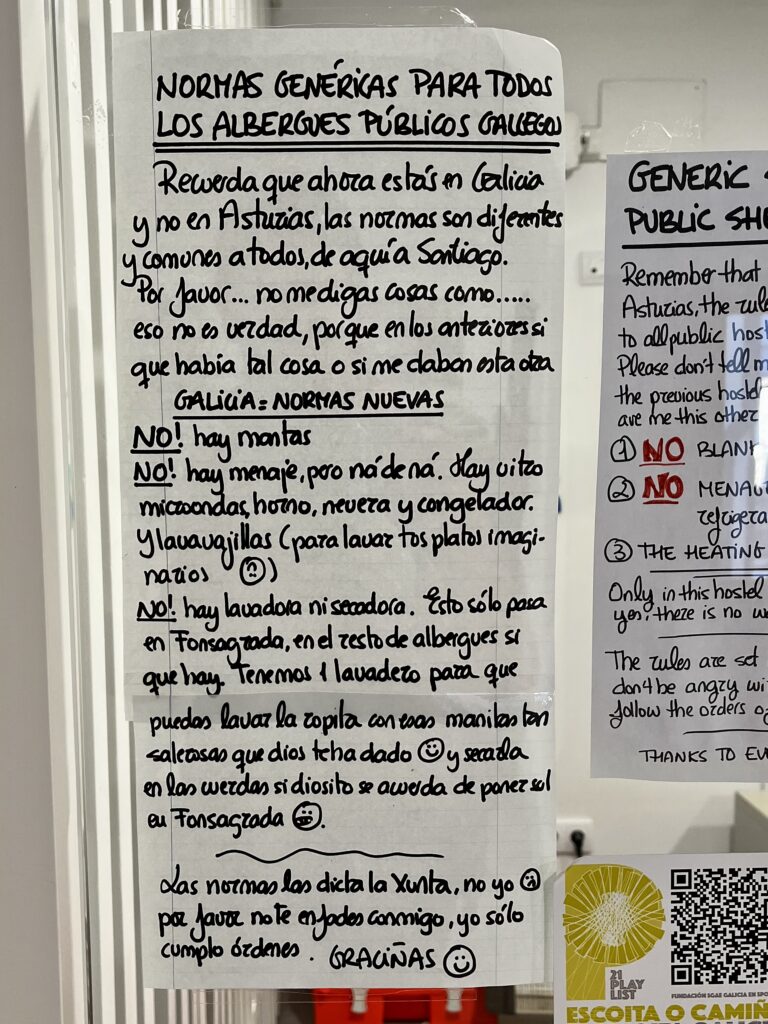I’m back now. Although I really don’t know if I’m not still there. This Holy Year, extended by the pandemic, I wanted to do the Camino Primitivo in winter. Yes, I knew it was going to be tough. Yes, I knew it was going to rain, snow and be muddy. Yes, I knew that many of the albergues were going to be closed. Of course I was aware of all the limitations but I also know that doing it in winter is special and more so this Camino Primitivo. For the hardness but also for the people that El Camino puts to walk with you.
First, the data
A very brief summary:
- Departure: Oviedo, 11/26/2022 (Saturday)
- Arrival: Santiago de Compostela, 12/08/2022 (Thursday), Day of the Immaculate Conception of the Virgin Mary.
- Total km (according to gps): 323,11 km
- Total stages: 13
- Fellow pilgrims with whom I met: Between 4 and 8 (we arrived in Santiago 4 of us).
Track of the Camino Primitivo in winter
I include the complete track of the Camino Primitivo in winter of this year. You can follow it directly from the Wikiloc application or download the track in GPX directly from there (about 20k points). If you want the high resolution one, just ask me for it.
As you can see, there are two very different sections: the Asturian including the first two stages in Galicia up to O Cádavo and the Galician, especially from Lugo and once it joins the Camino Francés in Melide. I am sorry for my Galician friends but I prefer the Asturian section both for the landscapes and for the welcome in the albergues, whether public or private.
Here you have the details of the 13 stages. Of course there are more alternatives always taking into account the availability of the albergues but these are mine. Main criteria: availability of public albergue. These albergues are the ones that keep open these less traveled Caminos than the Camino Francés and the Portuguese (take a look at the statistics…).
- Day 1: Oviedo – San Juan de Villapañada (30,95 km)
- Day 2: San Juan de Villapañada – Salas (21,72 km). Mythical albergue even if you have to make a small detour.
- Day 3: Salas – Tineo (20,34 km)
- Day 4: Tineo – Pola de Allande (26,46 km)
- Day 5: Pola de Allande – La Mesa (23,20 km). Passing through the Puerto del Palo (1.176m)
- Day 6: La Mesa – Castro (22,83 km). Passing by the Grandas de Salime reservoir.
- Day 7: Castro – A Fonsagrada (21,33 km). We entered Galicia.
- Day 8: A Fonsagrada – O Cádavo (25,49 km)
- Day 9: O Cádavo – Lugo (31,01). Start of the last 100 km
- Day 10: Lugo – San Román de Retorta (20,77 km)
- Day 11: San Roman de Retorta – Melide (28,57 km). Pilgrims on the Camino Francés join.
- Day 12: Melide – O Pedrouzo (36,97 km). Includes a small “detour” to the albergue 😉
- Day 13: O Pedrouzo – Santiago de Compostela (20,89 km)
Camino Primitivo in winter in 3D
I also leave you this 3D visualization so you can see where the Camino Primitivo passes through in winter, the beauty of the areas it crosses… and the slopes, both uphill and downhill: 8,150m of positive and negative gradient. I leave you the visualization of all the Caminos in 3D.
The best of the Camino Primitivo in winter
This year I wanted it to be special: Holy Year and to travel the original route of the first pilgrim, King Alfonso II El Casto. In addition to that, I always do it in winter, so the doubt was how much water or snow would fall or what temperatures I would have, especially when passing the Puerto del Palo area. In the end we were very lucky, only three days of rain out of the thirteen we walked… although that did not prevent us from having to deal with the accumulated mud.
The landscapes, the forests, the thousand streams, … are a marvel. To see them in all their splendor from the morning frost to these autumn/winter colors is a privilege. As I said before, the difference between the Asturian stages (including the first two up to O Cádavo in Galicia) and the Galician ones is very marked. This brings me to the people part.
As you can imagine, in winter the number of pilgrims doing the Camino drops a lot. And if this is true in general, extrapolate it to less traveled paths than the Camino Francés. To give you an idea, this year I have met less than 10 people on the same “day”. And this year I have once again been incredibly lucky with the fellow pilgrims with whom I have had the pleasure (and honor) of walking. Each one more interesting: Alessandra, Jesús, Miguel Ángel, Alberto,… and also Pilar and Pepe or Miriam.
And not only my fellow pilgrims. The hospitality as well. The hospitaleros of the public albergues but also of the private ones have been very kind and attentive to us. Making the end of the stage easier for us, helping us with the restaurants or the washer/dryer… or preparing dinners that were not even half normal (olé for Begoña). Things change when you approach the last 100 km (Lugo) and especially the Camino Francés (in Melide). The number of pilgrims increases and the albergues, even the public ones, become more “professional”, more “cold”… and especially in Galicia.

Anyway, the result, what counts the most is everything that is behind this photo. Those stories, those beers, those pains, that effort (that each one has to make… nobody walks it for you), that reward of the arrival,…

And a thousand other moments…




















